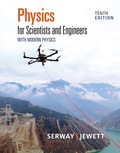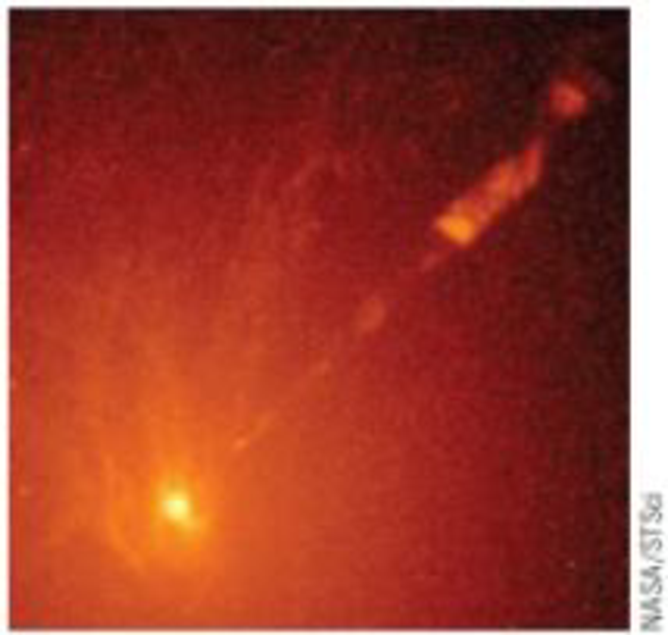
Physics for Scientists and Engineers with Modern Physics
10th Edition
ISBN: 9781337671729
Author: SERWAY
Publisher: Cengage
expand_more
expand_more
format_list_bulleted
Textbook Question
Chapter 38, Problem 21P
Figure P38.21 shows a jet of material (at the upper right) being ejected by galaxy M87 (at the lower left). Such jets are believed to be evidence of supermassive black holes at the center of a galaxy. Suppose two jets of material from the center of a galaxy are ejected in opposite directions. Both jets move at 0.750c relative to the galaxy center. Determine the speed of one jet relative to the other.
Figure P 38.21

Expert Solution & Answer
Trending nowThis is a popular solution!

Students have asked these similar questions
The drawing shows an edge-on view of two planar surfaces that intersect and are mutually perpendicular. Surface (1) has
an area of 1.90 m², while surface (2) has an area of 3.90 m². The electric field in the drawing is uniform and has a
magnitude of 215 N/C. Find the magnitude of the electric flux through surface (1 and 2 combined) if the angle 8 made
between the electric field with surface (2) is 30.0°.
Solve in Nm²/C
1
Ө
Surface 2
Surface 1
PROBLEM 5
What is the magnitude and direction of the resultant
force acting on the connection support shown here?
F₁ = 700 lbs
F2 = 250 lbs
70°
60°
F3 = 700 lbs
45°
F4 = 300 lbs
40°
Fs = 800 lbs
18°
Free Body Diagram
F₁ = 700 lbs
70°
250 lbs
60°
F3=
= 700 lbs
45°
F₁ = 300 lbs
40°
=
Fs 800 lbs
18°
PROBLEM 3
Cables A and B are Supporting a 185-lb wooden crate.
What is the magnitude of the tension force in each
cable?
A
20°
35°
185 lbs
Chapter 38 Solutions
Physics for Scientists and Engineers with Modern Physics
Ch. 38.1 - Which observer in Figure 38.1 sees the balls...Ch. 38.1 - Prob. 38.2QQCh. 38.4 - Suppose the observer O on the train in Figure 38.6...Ch. 38.4 - Prob. 38.4QQCh. 38.4 - Prob. 38.5QQCh. 38.4 - You are observing a spacecraft moving away from...Ch. 38.6 - You are driving on a freeway at a relativistic...Ch. 38.8 - Prob. 38.8QQCh. 38 - In a laboratory frame of reference, an observer...Ch. 38 - Prob. 2P
Ch. 38 - Prob. 3PCh. 38 - Prob. 4PCh. 38 - Prob. 5PCh. 38 - An astronaut is traveling in a space vehicle...Ch. 38 - Prob. 7PCh. 38 - You have been hired as an expert witness for an...Ch. 38 - Prob. 9PCh. 38 - Prob. 10PCh. 38 - Prob. 11PCh. 38 - A cube of steel has a volume of 1.00 cm3 and mass...Ch. 38 - Review. In 1963, astronaut Gordon Cooper orbited...Ch. 38 - You have an assistantship with a math professor in...Ch. 38 - Prob. 15PCh. 38 - Prob. 16PCh. 38 - A moving rod is observed to have a length of =...Ch. 38 - Prob. 18PCh. 38 - Prob. 19PCh. 38 - You have been hired as an expert witness in the...Ch. 38 - Figure P38.21 shows a jet of material (at the...Ch. 38 - Prob. 22PCh. 38 - Prob. 23PCh. 38 - Prob. 24PCh. 38 - Prob. 25PCh. 38 - Prob. 26PCh. 38 - Prob. 27PCh. 38 - (a) Find the kinetic energy of a 78.0-kg...Ch. 38 - Prob. 29PCh. 38 - Prob. 30PCh. 38 - Prob. 31PCh. 38 - Prob. 32PCh. 38 - Prob. 33PCh. 38 - Prob. 34PCh. 38 - Prob. 35PCh. 38 - Prob. 36PCh. 38 - Prob. 37PCh. 38 - Prob. 38PCh. 38 - Prob. 39PCh. 38 - An unstable particle with mass m = 3.34 1027 kg...Ch. 38 - Prob. 41PCh. 38 - Prob. 42APCh. 38 - Prob. 43APCh. 38 - Prob. 44APCh. 38 - Prob. 45APCh. 38 - Prob. 46APCh. 38 - Prob. 47APCh. 38 - Prob. 48APCh. 38 - Prob. 49APCh. 38 - Prob. 50APCh. 38 - Prob. 51APCh. 38 - Prob. 52APCh. 38 - The creation and study of new and very massive...Ch. 38 - Prob. 54CPCh. 38 - Prob. 55CP
Knowledge Booster
Learn more about
Need a deep-dive on the concept behind this application? Look no further. Learn more about this topic, physics and related others by exploring similar questions and additional content below.Similar questions
- The determined Wile E. Coyote is out once more to try to capture the elusive Road Runner of Loony Tunes fame. The coyote is strapped to a rocket, which provide a constant horizontal acceleration of 15.0 m/s2. The coyote starts off at rest 79.2 m from the edge of a cliff at the instant the roadrunner zips by in the direction of the cliff. If the roadrunner moves with constant speed, find the minimum velocity the roadrunner must have to reach the cliff before the coyote. (proper sig fig in answer)arrow_forwardPROBLEM 4 What is the resultant of the force system acting on the connection shown? 25 F₁ = 80 lbs IK 65° F2 = 60 lbsarrow_forwardThree point-like charges in the attached image are placed at the corners of an equilateral triangle as shown in the figure. Each side of the triangle has a length of 38.0 cm, and the point (C) is located half way between q1 and q3 along the side. Find the magnitude of the electric field at point (C). Let q1 = −2.80 µC, q2 = −3.40 µC, and q3 = −4.50 µC. Thank you.arrow_forward
- STRUCTURES I Homework #1: Force Systems Name: TA: PROBLEM 1 Determine the horizontal and vertical components of the force in the cable shown. PROBLEM 2 The horizontal component of force F is 30 lb. What is the magnitude of force F? 6 10 4 4 F = 600lbs F = ?arrow_forwardThe determined Wile E. Coyote is out once more to try to capture the elusive Road Runner of Loony Tunes fame. The coyote is strapped to a rocket, which provide a constant horizontal acceleration of 15.0 m/s2. The coyote starts off at rest 79.2 m from the edge of a cliff at the instant the roadrunner zips by in the direction of the cliff. If the roadrunner moves with constant speed, find the minimum velocity the roadrunner must have to reach the cliff before the coyote. (proper sig fig)arrow_forwardHello, I need some help with calculations for a lab, it is Kinematics: Finding Acceleration Due to Gravity. Equations: s=s0+v0t+1/2at2 and a=gsinθ. The hypotenuse,r, is 100cm (given) and a height, y, is 3.5 cm (given). How do I find the Angle θ1? And, for distance traveled, s, would all be 100cm? For my first observations I recorded four trials in seconds: 1 - 2.13s, 2 - 2.60s, 3 - 2.08s, & 4 - 1.95s. This would all go in the coloumn for time right? How do I solve for the experimental approximation of the acceleration? Help with trial 1 would be great so I can use that as a model for the other trials. Thanks!arrow_forward
- After the countdown at the beginning of a Mario Kart race, Bowser slams on the gas, taking off from rest. Bowser get up to a full speed of 25.5 m/s due to an acceleration of 10.4 m/s2. A)How much time does it take to reach full speed? B) How far does Bowser travel while accelerating?arrow_forwardThe drawing in the image attached shows an edge-on view of two planar surfaces that intersect and are mutually perpendicular. Side 1 has an area of 1.90 m^2, Side 2 has an area of 3.90 m^2, the electric field in magnitude is around 215 N/C. Please find the electric flux magnitude through side 1 and 2 combined if the angle (theta) made between the electric field with side 2 is 30.0 degrees. I believe side 1 is 60 degrees but could be wrong. Thank you.arrow_forwardAfter the countdown at the beginning of a Mario Kart race, Bowser slams on the gas, taking off from rest. Bowser get up to a full speed of 25.5 m/s due to an acceleration of 10.4 m/s2.arrow_forward
- The drawing in the image attached shows an edge-on view of two planar surfaces that intersect and are mutually perpendicular. Side 1 has an area of 1.90 m^2, Side 2 has an area of 3.90 m^2, the electric field in magnitude is around 215 N/C. Please find the electric flux magnitude through side 1 and 2 combined if the angle (theta) made between the electric field with side 2 is 30.0 degrees. Thank you.arrow_forwardThe drawing in the image attached shows an edge-on view of two planar surfaces that intersect and are mutually perpendicular. Surface (1) has an area of 1.90 m^2, while Surface (2) has an area of 3.90 m^2. The electric field in magnitude of 215 N/C. Please find the magnitude of the electric flux through surface (with both 1 and 2 combined) if the angle (theta) made between the electric field with surface (2) is 30.0 degrees. Thank you.arrow_forwardThe drawing in the image attached shows an edge-on view of two planar surfaces that intersect and are mutually perpendicular. Surface (1) has an area of 1.90 m^2, while Surface (2) has an area of 3.90 m^2. The electric field in magnitude of 215 N/C. Please find the magnitude of the electric flux through surface (with both 1 and 2 combined) if the angle (theta) made between the electric field with surface (2) is 30.0 degrees. Thank you.arrow_forward
arrow_back_ios
SEE MORE QUESTIONS
arrow_forward_ios
Recommended textbooks for you
 Physics for Scientists and Engineers with Modern ...PhysicsISBN:9781337553292Author:Raymond A. Serway, John W. JewettPublisher:Cengage Learning
Physics for Scientists and Engineers with Modern ...PhysicsISBN:9781337553292Author:Raymond A. Serway, John W. JewettPublisher:Cengage Learning Physics for Scientists and EngineersPhysicsISBN:9781337553278Author:Raymond A. Serway, John W. JewettPublisher:Cengage Learning
Physics for Scientists and EngineersPhysicsISBN:9781337553278Author:Raymond A. Serway, John W. JewettPublisher:Cengage Learning Physics for Scientists and Engineers: Foundations...PhysicsISBN:9781133939146Author:Katz, Debora M.Publisher:Cengage Learning
Physics for Scientists and Engineers: Foundations...PhysicsISBN:9781133939146Author:Katz, Debora M.Publisher:Cengage Learning University Physics Volume 3PhysicsISBN:9781938168185Author:William Moebs, Jeff SannyPublisher:OpenStax
University Physics Volume 3PhysicsISBN:9781938168185Author:William Moebs, Jeff SannyPublisher:OpenStax Principles of Physics: A Calculus-Based TextPhysicsISBN:9781133104261Author:Raymond A. Serway, John W. JewettPublisher:Cengage Learning
Principles of Physics: A Calculus-Based TextPhysicsISBN:9781133104261Author:Raymond A. Serway, John W. JewettPublisher:Cengage Learning Modern PhysicsPhysicsISBN:9781111794378Author:Raymond A. Serway, Clement J. Moses, Curt A. MoyerPublisher:Cengage Learning
Modern PhysicsPhysicsISBN:9781111794378Author:Raymond A. Serway, Clement J. Moses, Curt A. MoyerPublisher:Cengage Learning

Physics for Scientists and Engineers with Modern ...
Physics
ISBN:9781337553292
Author:Raymond A. Serway, John W. Jewett
Publisher:Cengage Learning

Physics for Scientists and Engineers
Physics
ISBN:9781337553278
Author:Raymond A. Serway, John W. Jewett
Publisher:Cengage Learning

Physics for Scientists and Engineers: Foundations...
Physics
ISBN:9781133939146
Author:Katz, Debora M.
Publisher:Cengage Learning

University Physics Volume 3
Physics
ISBN:9781938168185
Author:William Moebs, Jeff Sanny
Publisher:OpenStax

Principles of Physics: A Calculus-Based Text
Physics
ISBN:9781133104261
Author:Raymond A. Serway, John W. Jewett
Publisher:Cengage Learning

Modern Physics
Physics
ISBN:9781111794378
Author:Raymond A. Serway, Clement J. Moses, Curt A. Moyer
Publisher:Cengage Learning
Time Dilation - Einstein's Theory Of Relativity Explained!; Author: Science ABC;https://www.youtube.com/watch?v=yuD34tEpRFw;License: Standard YouTube License, CC-BY